Why Proper Wool Sock Care Matters?
A single washing mistake can turn premium wool socks into an unwearable, shrunken mess. Heat, friction, and harsh detergents are the silent culprits behind complaints, returns, and disappointed customers. For brands and retailers, these mishaps aren’t just inconveniences—they’re unnecessary revenue losses.
Educating customers on proper care ensures they get the most from their purchase, while businesses benefit from fewer quality concerns and stronger brand loyalty. The right washing techniques help maintain softness, prevent shrinkage, and extend wearability, reinforcing the premium value of every pair.
This guide unpacks the essential steps to keep wool socks in top condition—from choosing the best detergent to drying methods that preserve elasticity. By offering expert care instructions, brands can elevate their product appeal, reduce complaints, and keep customers coming back.

Understanding Wool: Properties and Care Requirements
Wool socks offer unmatched benefits for end customers, including superior warmth, breathability, and durability—qualities that make them a standout choice in the market. These advantages come from wool’s natural fibers, which provide insulation by trapping air, manage moisture by wicking sweat, and naturally resist odors, ensuring long-lasting comfort. However, these premium features depend on proper care, a key piece of knowledge for brands and retailers to share with their customers. Excessive heat, rough agitation, or strong detergents can harm wool, causing shrinkage, pilling, or loss of softness—common issues that lead to customer dissatisfaction. To solve this, we recommend gentle washing in cool water with a mild detergent and air drying, preserving the socks’ quality and extending their lifespan.
For brands and retailers, this care education not only boosts customer trust and satisfaction but also elevates the perceived value of your wool sock offerings. As a foreign trade factory with deep expertise in wool sock production, we invite you to partner with us. We specialize in crafting custom wool socks tailored to your specifications, helping you deliver exceptional products that meet market demands and delight your customers.
Pre-Wash Preparation: Essential Steps for Success
Proper preparation is the key to preserving the integrity of wool socks. Taking a few extra steps before washing ensures these premium garments maintain their comfort, durability, and shape. Here’s how brands and retailers can guide customers through the crucial pre-wash process to reduce shrinkage, pilling, and unnecessary wear.
Reading and Interpreting Care Labels
Those tiny care tags hold valuable information that can make or break the longevity of wool socks. Different fiber blends and manufacturing techniques call for varying care requirements, making it essential to decode the symbols correctly.
- Water Temperature Guidelines: Some wool socks can handle warm water, while others require cold washes to prevent shrinkage. Always check for a temperature icon to ensure compliance.
- Detergent Restrictions: Certain wool blends may not tolerate standard laundry detergents. Look for instructions that specify wool-safe formulas and avoid harsh chemicals that can weaken fibers.
- Drying Instructions: Heat exposure can be damaging. If the label warns against tumble drying, opt for air drying to maintain elasticity and fit.
Providing customers with clear guidance on reading labels helps them avoid irreversible damage and enhances the reputation of brands offering well-maintained products.
Sorting Socks for Optimal Washing
Sorting may seem like a minor detail, but it plays a significant role in keeping wool socks in pristine condition. Separating them properly reduces the risk of color bleeding and prevents abrasive fabrics from causing friction damage.
- By Color: Dark and light shades should always be washed separately to avoid unwanted dye transfer. Even naturally colored wool can be affected by other fabrics bleeding in the wash.
- By Soil Level: Heavily soiled socks should not be mixed with lightly worn pairs. Pre-rinsing or spot-cleaning visible dirt prevents contaminants from embedding deeper into the fabric during washing.
- By Fabric Type: Avoid washing wool socks with rough-textured garments like denim or items with zippers, as these can cause pilling or snagging. Using a laundry bag adds an extra layer of protection.
Turn Over: A Crucial Step for Deep Cleaning
Before washing, always turn socks inside out. During wear, dirt and sweat tend to accumulate inside, especially in cushioned designs where the knitted loops trap debris. Reversing the socks exposes these areas, allowing for a more effective clean while protecting the outer surface from excessive wear.
Washing Techniques: Best Practices for Wool Socks
Proper washing techniques help maintain the quality and lifespan of wool socks, ensuring they stay soft and durable for longer. Whether hand washing or using a machine, following the right approach prevents shrinkage, fiber damage, and unnecessary wear.
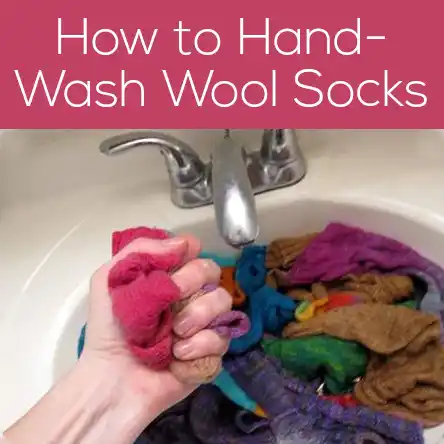
Hand Washing: The Gentle Approach
Hand washing remains the safest way to clean wool socks without compromising their texture. This method minimizes stress on the fibers and helps retain their elasticity.
- Prepare a Basin – Fill with lukewarm water (around 30°C), ensuring it’s neither too hot nor too cold.
- Use a Wool-Safe Detergent – Mix in a mild detergent designed for delicate fabrics, avoiding any harsh chemicals or bleaching agents.
- Turn Socks Inside Out – This protects the outer surface and allows for better cleaning of areas prone to sweat buildup.
- Soak and Gently Clean – Let the socks sit for 5–10 minutes before gently massaging dirt out. Avoid vigorous scrubbing or twisting.
- Rinse Thoroughly – Drain the soapy water and refill with clean, lukewarm water to remove all detergent residues.
- Press Out Excess Water – Instead of wringing, press the socks between a dry towel to maintain their original shape.
This method ensures a thorough clean without stretching or weakening the fibers.
Machine Washing: When It’s Safe and How to Do It
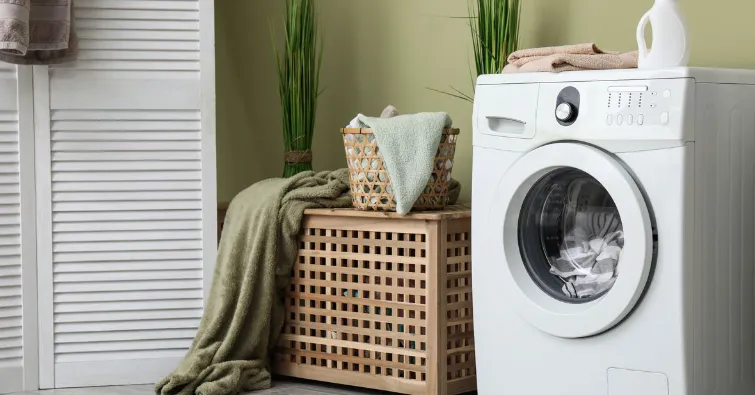
While hand washing is ideal, certain wool socks are machine-washable when handled correctly. Follow these best practices to prevent fabric damage:
- Turn Inside Out & Use a Laundry Bag – This reduces friction and protects the delicate wool surface.
- Select a Gentle Cycle – Opt for a wool or delicate setting with low agitation to avoid fiber stress.
- Maintain Proper Water Temperature – Keep it at 30°C or lower to prevent shrinkage or hardening.
- Use Minimal Detergent – Too much soap can leave residue, affecting softness and comfort.
- Avoid Spinning & High Heat Drying – Excessive spinning can stretch fibers, while heat can lead to shrinkage.
By following these steps, wool socks remain clean without losing their natural feel and fit.
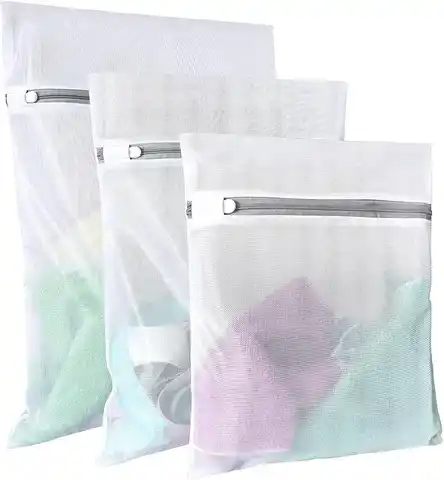
Choosing the Right Detergent for Wool
Using the correct detergent is crucial to preserving the softness and integrity of wool fibers. Here’s what to look for:
- Wool-Specific Formulas – These are designed to clean while maintaining moisture balance in the fibers.
- Mild & pH-Balanced – Harsh chemicals or alkaline detergents can cause wool to become brittle.
- Avoid Fabric Softeners & Bleach – These weaken fibers over time and may cause unwanted stiffness.
Drying Wool Socks: Methods to Maintain Shape and Quality
Drying wool socks the right way is just as important as washing them. Proper techniques help maintain their structure, prevent shrinkage, and extend their lifespan. Whether air drying or using a dryer with caution, these methods ensure wool socks stay in optimal condition.
Air Drying: The Recommended Approach
Air drying is the safest and most effective method to preserve the shape and texture of wool socks. Unlike synthetic materials, wool is highly sensitive to heat and excessive moisture.
- Gently Remove Excess Water – Instead of wringing, lightly press the socks between a dry towel to absorb moisture.
- Lay Flat on a Clean Surface – Avoid hanging, as this can stretch the fibers. A flat, well-ventilated area is ideal for even drying.
- Keep Away from Direct Sunlight – UV exposure can weaken fibers and cause colors to fade over time. Opt for shade or indoor drying near a gentle airflow.
Following these steps prevents unnecessary stress on the fabric and ensures a long-lasting, comfortable fit.
Using a Dryer: Risks and Precautions
While air drying is preferred, some may be tempted to use a dryer for convenience. However, this carries significant risks:
- Heat Causes Shrinkage – Even low heat settings can cause wool fibers to contract, making socks too tight or stiff.
- Loss of Softness – High-speed tumbling can disrupt the natural texture, reducing comfort and elasticity.
- Risk of Fiber Damage – Over time, repeated dryer use weakens wool fibers, shortening their lifespan.
For those who must use a dryer, always select the lowest heat setting and place the socks in a mesh laundry bag to minimize friction. Adding a dry towel can also help reduce drying time while protecting the fibers.
Reshaping Your Socks: Why It Matters
After washing and drying, wool socks should be reshaped to maintain their original fit. This small but crucial step prevents unwanted stretching or shrinkage.
- Gently Pat and Align – Lay the socks flat and use your hands to lightly press them back into their natural shape.
- Adjust the Toe and Cuff Areas – Ensure they are evenly spread out, avoiding bunching or curling.
- Let Them Fully Dry in Position – Any adjustments should be made while damp, as the fibers set in place as they dry.
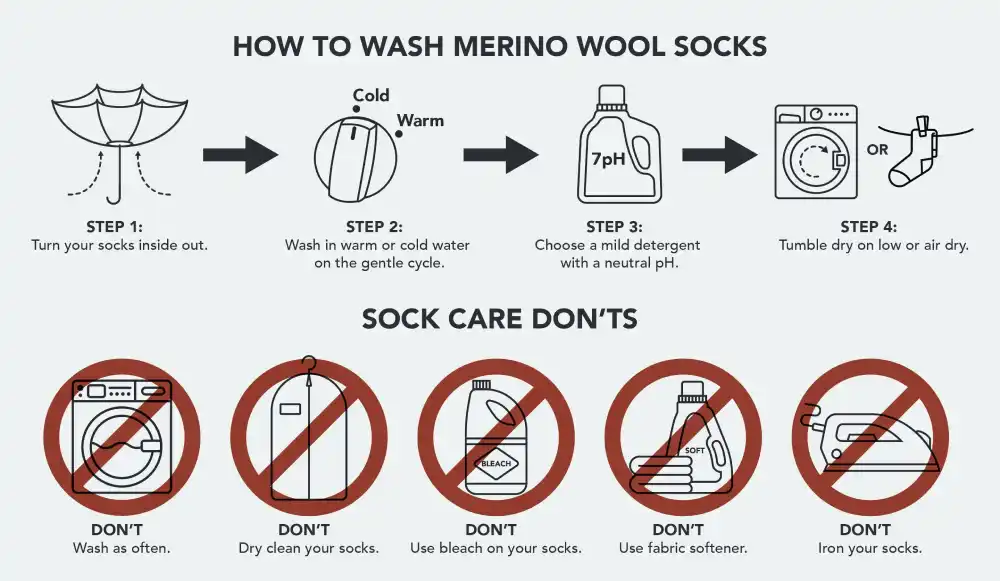
Common Mistakes in Wool Sock Care and How to Avoid Them
Even the highest-quality wool products can lose their softness and durability if not handled correctly. Many customers unknowingly make simple mistakes that lead to shrinkage, misshaping, or fiber damage. Educating them on proper techniques not only extends the product’s lifespan but also reduces unnecessary returns and complaints.
Hot Water: A Costly Mistake
One of the biggest culprits behind ruined wool is exposure to excessive heat. High temperatures cause fibers to contract, resulting in a stiff, shrunken texture that’s nearly impossible to reverse.
- Stick to Lukewarm Water – Always wash at 30°C or below to preserve structure and elasticity.
- Avoid Sudden Temperature Changes – A quick shift from warm to cold water can shock fibers, leading to irreversible shrinkage.
- Skip Boiling Washes – Some customers believe hotter water cleans better, but it actually weakens the natural properties of the material.
Excessive Agitation: A Fiber’s Worst Enemy
Rough handling leads to pilling, stretching, and premature wear. Unlike synthetic options, wool requires a delicate approach to maintain its softness.
- Skip Harsh Scrubbing – Gently press and squeeze instead of rubbing the fabric aggressively.
- Use Protective Measures for Machine Washes – A mesh bag helps reduce friction while ensuring a proper clean.
- Select Low-Agitation Cycles – The delicate or wool setting minimizes fiber stress, preserving the original shape.
By promoting gentle handling, brands can ensure long-term durability and enhanced customer satisfaction.
Ignoring Care Labels: A Common Oversight
Skipping instructions is a frequent mistake that leads to preventable issues. From using the wrong cleaning agents to improper drying techniques, disregarding guidelines can quickly ruin a great product.
- Risk: Unwanted Shrinking – Incorrect wash temperatures lead to irreversible size reduction.
- Risk: Fiber Weakening – Harsh chemicals, bleach, or fabric softeners can break down natural elasticity.
- Solution for Mistakes – If shrinkage occurs, soaking in lukewarm water with a mild conditioner may help restore flexibility.
Helping customers avoid these pitfalls ensures fewer product complaints, stronger brand loyalty, and an overall better user experience.
Advanced Care Tips: Ensuring Longevity and Performance
Proper maintenance goes beyond routine washing—knowing how to remove stains, store properly, and seek expert care can extend the life of wool socks. These simple yet effective strategies help preserve quality, ensuring customers get lasting comfort and durability.
Stain Removal: Safe Methods for Wool
Removing stains requires a careful approach to avoid damaging delicate fibers. Harsh scrubbing or strong chemicals can lead to thinning and discoloration.
- Blot Immediately – Dab spills with a clean cloth to absorb excess liquid before they set.
- Use Gentle Solutions – A mix of lukewarm water and mild detergent helps lift most stains without weakening the material.
- Avoid Rubbing – Press lightly instead of scrubbing to prevent pilling and surface damage.
For stubborn stains, a short soak in cool water before gentle washing can improve results without compromising softness.
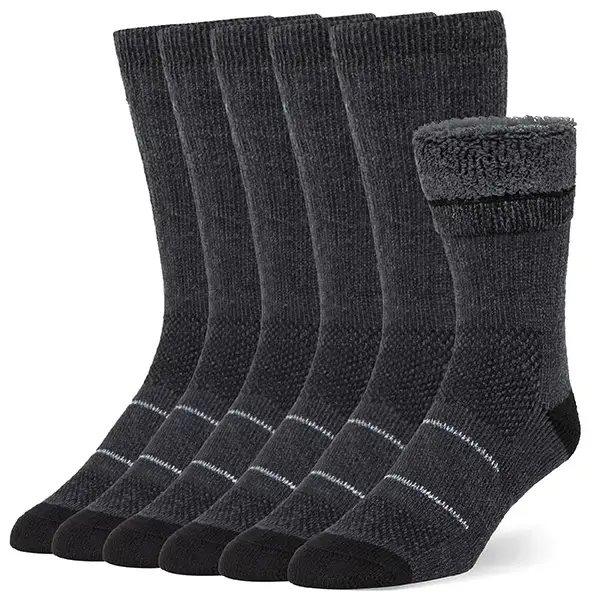
Proper Storage: Keeping Socks Fresh and Intact
Storing wool correctly prevents stretching, moisture buildup, and unwanted fiber damage. A few simple precautions keep them in prime condition between wears.
- Store in a Dry, Cool Space – Humidity can lead to mildew, so always choose a moisture-free environment.
- Fold Instead of Hanging – Prevents loss of shape and helps maintain elasticity over time.
- Use Natural Protectants – Placing cedar blocks or lavender sachets in storage areas deters moths without chemical exposure.
Educating customers on proper storage helps brands reduce premature wear complaints and enhance product longevity.
When to Seek Professional Cleaning
Certain situations call for expert care to maintain wool’s natural texture and resilience. Knowing when to opt for professional cleaning prevents accidental damage.
- Persistent Stains – If blotting and soaking fail, expert treatments help remove deep discoloration.
- Specialty Fabrics – Blends with delicate fibers like cashmere require professional handling to avoid fiber breakdown.
- Restoring Texture – Over time, expert reconditioning can help refresh worn areas and remove excessive pilling.
Offering customers guidance on these advanced care methods ensures better long-term performance and reduces unnecessary product replacements.
Conclusion: Empowering Your Customers with Knowledge
Proper care is the key to preserving wool socks, ensuring they stay soft, durable, and comfortable over time. From using the right washing methods to proper drying and storage, every step plays a role in extending product longevity. By educating customers on these best practices, brands can reduce complaints, minimize returns, and build stronger loyalty through high-quality, long-lasting products.
When customers understand how to care for their purchases, they experience better value—leading to repeat business and stronger brand trust. By working with a trusted supplier, brands can not only deliver premium socks but also provide the right aftercare guidance—boosting satisfaction and setting themselves apart in the market.
FAQs
How can we educate customers on washing wool socks to prevent returns?
Providing detailed care instructions with your product packaging or online store listing helps minimize customer errors. Consider including a small care guide with each purchase or printing washing symbols on the label to clearly communicate proper handling.
What should customers do if their wool socks shrink?
If shrinkage occurs, they can try:
- Soaking socks in lukewarm water mixed with a few drops of hair conditioner or wool softener.
- Gently stretching them back to their original size.
- Laying them flat to dry while maintaining shape.
This method may restore some elasticity, but results depend on the extent of shrinkage.
How can brands prevent wool socks from pilling?
Pilling happens due to fiber friction during wear and washing. To minimize this:
- Encourage hand washing or gentle machine cycles.
- Avoid washing with rough fabrics like denim.
- Use a laundry bag to reduce surface abrasion.
- For existing pilling, recommend a fabric comb or wool shaver to remove excess fuzz.
Why do some wool socks feel itchy?
Itchiness often comes from lower-quality wool with larger fibers. For a softer experience, choose socks made from merino wool, which has finer fibers that feel smooth against the skin.
Do you offer eco-friendly wool sock options?
Yes! We provide options made from ethically sourced wool and use environmentally friendly processing techniques. These appeal to sustainability-conscious brands and consumers.
